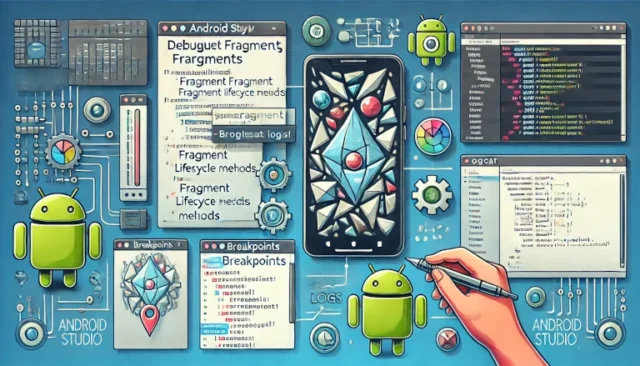Fragments in Android provide a flexible way to design dynamic and reusable user interfaces. However, debugging fragments ( debug Fragments ) can sometimes be challenging, especially when dealing with lifecycle issues, state management, or interactions with other components. If you’re wondering how to debug fragments effectively in Android, this guide has you covered. We’ll delve into the fundamentals, practical debugging steps, common issues, and solutions, ensuring you can tackle fragment-related problems with confidence.
What Are Fragments in Android?
Fragments are modular sections of a user interface that can be combined to create dynamic and responsive layouts. Unlike activities, fragments are designed to be embedded within activities and allow for a more scalable design in Android apps. They are particularly useful for implementing reusable components and multi-pane layouts.
However, fragments come with their own complexities, especially around their lifecycle, making debugging an essential skill for Android developers.
How Fragment Debugging Works
Debugging fragments in Android involves understanding their lifecycle, identifying where issues occur, and utilizing tools like Logcat, the Android Debug Bridge (ADB), and breakpoints in Android Studio.
💡 Tip: Fragment lifecycle methods like
onCreate(),onCreateView(), andonDestroyView()are often key points where debugging efforts should focus.
Setting Up for Debugging Fragments
Before diving into debugging, ensure your development environment is ready. Use Android Studio, as it provides built-in tools for debugging, such as breakpoints, Logcat, and layout inspection.
Add Logs for Lifecycle Tracking
Adding log statements in each lifecycle method is a simple yet effective way to debug fragments. For example:
@Override
public void onCreate(Bundle savedInstanceState) {
super.onCreate(savedInstanceState);
Log.d("FragmentDebug", "onCreate called");
}
@Override
public View onCreateView(LayoutInflater inflater, ViewGroup container, Bundle savedInstanceState) {
Log.d("FragmentDebug", "onCreateView called");
return inflater.inflate(R.layout.fragment_example, container, false);
}
@Override
public void onDestroyView() {
super.onDestroyView();
Log.d("FragmentDebug", "onDestroyView called");
}
Common Issues in Fragment Debugging
1. Fragment Lifecycle Mismatch
Understanding the lifecycle of fragments is crucial. Unlike activities, fragments have additional lifecycle methods that interact with their hosting activities. Use the Android documentation as a reference for the fragment lifecycle chart.
2. NullPointerExceptions
This often happens when the fragment’s view is accessed after onDestroyView() has been called. To avoid this, always check if the view is null before accessing it.
if (getView() != null) {
// Access views safely here
}
3. Fragment Transactions and Back Stack Issues
Improper fragment transactions can cause unexpected behavior. Use FragmentManager to carefully handle transactions. For instance:
FragmentTransaction transaction = getSupportFragmentManager().beginTransaction();
transaction.replace(R.id.fragment_container, new ExampleFragment());
transaction.addToBackStack(null);
transaction.commit();
Effective Tools for Debugging Fragments
- Logcat
The Android Logcat tool provides real-time logs to identify errors or unexpected behavior in fragments. Use filters to focus on fragment-related logs. - Breakpoints in Android Studio
Add breakpoints to lifecycle methods or problematic areas in your code to inspect variable states during runtime. - Layout Inspector
Use Android Studio’s Layout Inspector to visualize and debug the UI components in your fragment. This tool helps identify layout issues and missing views.
Practical Debugging Example
Let’s debug a common issue: a button click in a fragment that doesn’t trigger the desired action.
Check if the OnClickListener is set up correctly in onViewCreated():
@Override
public void onViewCreated(View view, Bundle savedInstanceState) {
super.onViewCreated(view, savedInstanceState);
Button myButton = view.findViewById(R.id.my_button);
myButton.setOnClickListener(v -> {
Log.d("FragmentDebug", "Button clicked");
// Your action here
});
}
If the button click doesn’t work, verify that the correct layout is being inflated in onCreateView().
Troubleshooting Common Fragment Issues
If the fragment does not display properly:
- Ensure the correct layout is used in
onCreateView(). - Verify the fragment transaction and container ID match.
If the fragment crashes due to a NullPointerException:
- Ensure all view bindings are initialized before accessing them.
If fragment state is not preserved:
- Use
setRetainInstance(true)for retaining fragments across configuration changes.
Why Debugging Fragments is Important
Debugging fragments effectively ensures smoother app performance, better user experiences, and fewer runtime errors. With their modular nature, fragments are pivotal in modern Android development, and understanding how to debug them is a key skill for every developer.
Final Thoughts
Debugging fragments in Android doesn’t have to be intimidating. By understanding their lifecycle, using tools like Logcat and Layout Inspector, and applying practical techniques, you can resolve issues efficiently. The steps and solutions provided here will help you master fragment debugging, ensuring your Android app runs flawlessly.
